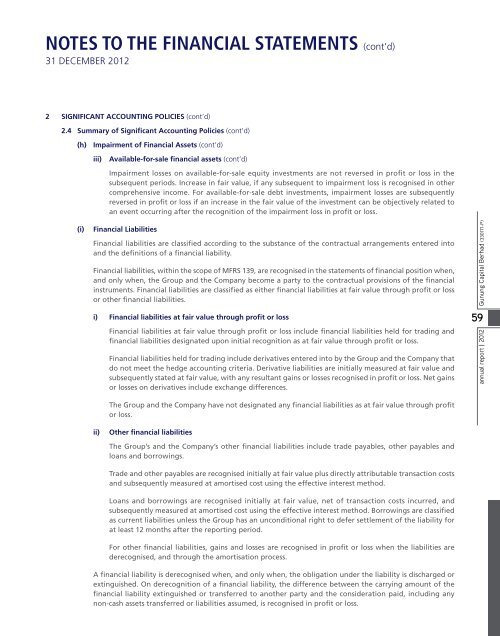Download PDF - ChartNexus
Download PDF - ChartNexus
Download PDF - ChartNexus
You also want an ePaper? Increase the reach of your titles
YUMPU automatically turns print PDFs into web optimized ePapers that Google loves.
NOTES TO THE FINANCIAL STATEMENTS (cont’d)<br />
31 DECEMBER 2012<br />
2 SIGNIFICANT ACCOUNTING POLICIES (cont’d)<br />
2.4 Summary of Significant Accounting Policies (cont’d)<br />
(h) Impairment of Financial Assets (cont’d)<br />
iii) Available-for-sale financial assets (cont’d)<br />
Impairment losses on available-for-sale equity investments are not reversed in profit or loss in the<br />
subsequent periods. Increase in fair value, if any subsequent to impairment loss is recognised in other<br />
comprehensive income. For available-for-sale debt investments, impairment losses are subsequently<br />
reversed in profit or loss if an increase in the fair value of the investment can be objectively related to<br />
an event occurring after the recognition of the impairment loss in profit or loss.<br />
(i) Financial Liabilities<br />
Financial liabilities are classified according to the substance of the contractual arrangements entered into<br />
and the definitions of a financial liability.<br />
Financial liabilities, within the scope of MFRS 139, are recognised in the statements of financial position when,<br />
and only when, the Group and the Company become a party to the contractual provisions of the financial<br />
instruments. Financial liabilities are classified as either financial liabilities at fair value through profit or loss<br />
or other financial liabilities.<br />
i) Financial liabilities at fair value through profit or loss<br />
Financial liabilities at fair value through profit or loss include financial liabilities held for trading and<br />
financial liabilities designated upon initial recognition as at fair value through profit or loss.<br />
Financial liabilities held for trading include derivatives entered into by the Group and the Company that<br />
do not meet the hedge accounting criteria. Derivative liabilities are initially measured at fair value and<br />
subsequently stated at fair value, with any resultant gains or losses recognised in profit or loss. Net gains<br />
or losses on derivatives include exchange differences.<br />
The Group and the Company have not designated any financial liabilities as at fair value through profit<br />
or loss.<br />
ii) Other financial liabilities<br />
The Group’s and the Company’s other financial liabilities include trade payables, other payables and<br />
loans and borrowings.<br />
Trade and other payables are recognised initially at fair value plus directly attributable transaction costs<br />
and subsequently measured at amortised cost using the effective interest method.<br />
Loans and borrowings are recognised initially at fair value, net of transaction costs incurred, and<br />
subsequently measured at amortised cost using the effective interest method. Borrowings are classified<br />
as current liabilities unless the Group has an unconditional right to defer settlement of the liability for<br />
at least 12 months after the reporting period.<br />
For other financial liabilities, gains and losses are recognised in profit or loss when the liabilities are<br />
derecognised, and through the amortisation process.<br />
A financial liability is derecognised when, and only when, the obligation under the liability is discharged or<br />
extinguished. On derecognition of a financial liability, the difference between the carrying amount of the<br />
financial liability extinguished or transferred to another party and the consideration paid, including any<br />
non-cash assets transferred or liabilities assumed, is recognised in profit or loss.<br />
Gunung Capital Berhad (330171-P)<br />
59<br />
annual report | 2012

















